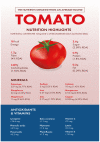Tomatoes: An Extensive Review of the Associated Health Impacts of Tomatoes and Factors That Can Affect Their Cultivation
- PMID: 35205105
- PMCID: PMC8869745
- DOI: 10.3390/biology11020239
Tomatoes: An Extensive Review of the Associated Health Impacts of Tomatoes and Factors That Can Affect Their Cultivation
Abstract
This review outlines the health benefits associated with the regular consumption of tomatoes and tomato products. The first section provides a detailed account of the horticultural techniques that can impact the quality of the fruit and its nutritional properties, including water availability, light intensity, temperature, and growing media. The next section provides information on the components of tomato that are likely to contribute to its health effects. The review then details some of the health benefits associated with tomato consumption, including anticancer properties, cardiovascular and neurodegenerative diseases and skin health. This review also discusses the impact tomatoes can have on the gut microbiome and associated health benefits, including reducing the risk of inflammatory bowel diseases. Other health benefits of eating tomatoes are also discussed in relation to effects on diabetes, the immune response, exercise recovery, and fertility. Finally, this review also addresses the negative effects that can occur as a result of overconsumption of tomato products and lycopene supplements.
Keywords: cardiovascular; diabetes; exercise; fertility; horticulture; lycopene; microbiome; neurodegenerative; skin health; tomato; vitamin C.
Conflict of interest statement
The authors declare no conflict of interest.
Figures
Similar articles
-
The Bacterial Microbiome of the Tomato Fruit Is Highly Dependent on the Cultivation Approach and Correlates With Flavor Chemistry.Front Plant Sci. 2021 Dec 24;12:775722. doi: 10.3389/fpls.2021.775722. eCollection 2021. Front Plant Sci. 2021. PMID: 35003161 Free PMC article.
-
Lycopene Content of Tomato Products: Its Stability, Bioavailability and In Vivo Antioxidant Properties.J Med Food. 2001 Spring;4(1):9-15. doi: 10.1089/10966200152053668. J Med Food. 2001. PMID: 12639283
-
Lycopene: a review of its potential as an anticancer agent.Curr Med Chem Anticancer Agents. 2005 Nov;5(6):627-35. doi: 10.2174/156801105774574667. Curr Med Chem Anticancer Agents. 2005. PMID: 16305484 Review.
-
Screening of In Vitro Health Benefits of Tangerine Tomatoes.Antioxidants (Basel). 2019 Jul 19;8(7):230. doi: 10.3390/antiox8070230. Antioxidants (Basel). 2019. PMID: 31331031 Free PMC article.
-
Bioactivities of phytochemicals present in tomato.J Food Sci Technol. 2018 Aug;55(8):2833-2849. doi: 10.1007/s13197-018-3221-z. Epub 2018 Jun 1. J Food Sci Technol. 2018. PMID: 30065393 Free PMC article. Review.
Cited by
-
A Diet Supplemented with Polyphenols, Prebiotics and Omega-3 Fatty Acids Modulates the Intestinal Microbiota and Improves the Profile of Metabolites Linked with Anxiety in Dogs.Biology (Basel). 2022 Jun 28;11(7):976. doi: 10.3390/biology11070976. Biology (Basel). 2022. PMID: 36101356 Free PMC article.
-
Characterization of Lithuanian Tomato Varieties and Hybrids Using Phenotypic Traits and Molecular Markers.Plants (Basel). 2024 Aug 2;13(15):2143. doi: 10.3390/plants13152143. Plants (Basel). 2024. PMID: 39124261 Free PMC article.
-
Effect of CO2 Elevation on Tomato Gas Exchange, Root Morphology and Water Use Efficiency under Two N-Fertigation Levels.Plants (Basel). 2024 Aug 26;13(17):2373. doi: 10.3390/plants13172373. Plants (Basel). 2024. PMID: 39273857 Free PMC article.
-
Effects of Plant Substitutes for Nitrite on the Technological Characteristics of Fermented Sausages: A Comprehensive Review.Food Sci Nutr. 2025 Apr 18;13(4):e70186. doi: 10.1002/fsn3.70186. eCollection 2025 Apr. Food Sci Nutr. 2025. PMID: 40255544 Free PMC article. Review.
-
The effects of post-harvest pretreatments and drying methods on in vitro bioaccessibility of phenolics and carotenoids in tomato (Solanum lycopersicum) cultivars.J Food Sci. 2025 Feb;90(2):e70001. doi: 10.1111/1750-3841.70001. J Food Sci. 2025. PMID: 39949245 Free PMC article.
References
-
- Bhowmik D., Kumar K.S., Paswan S., Srivastava S. Tomato-A Natural Medicine and Its Health Benefits. J. Pharmacogn. Phytochem. 2012;1:33–43.
-
- Borguini R.G., Ferraz Da Silva Torres E.A. Tomatoes and Tomato Products as Dietary Sources of Antioxidants. Food Rev. Int. 2009;25:313–325. doi: 10.1080/87559120903155859. - DOI
-
- Viuda-Martos M., Sanchez-Zapata E., Sayas-Barberá E., Sendra E., Pérez-Álvarez J.A., Fernández-López J. Tomato and Tomato Byproducts. Human Health Benefits of Lycopene and Its Application to Meat Products: A Review. Crit. Rev. Food Sci. Nutr. 2014;54:1032–1049. doi: 10.1080/10408398.2011.623799. - DOI - PubMed
-
- Rao A.V., Agarwal S. Role of Lycopene as Antioxidant Carotenoid in the Prevention of Chronic Diseases: A Review. Nutr. Res. 1999;19:305–323. doi: 10.1016/S0271-5317(98)00193-6. - DOI
Publication types
LinkOut - more resources
Full Text Sources


